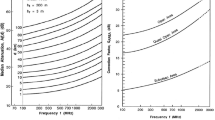Abstract
Although Okumura–Hata prediction model has been a widely used model to estimate radio network coverage, its application in railways environment requires validation and additional studies. This paper presents the main results on a study based on measurements campaigns, and identifies significant differences in parameters that characterize the radio propagation in railways environment, for the 900 MHz band. Both the propagation slope and standard deviation measured values are presented in this work. For validation, the developed model setup was used in the radio planning process, setting a live Global System for Mobile Communications-Railway pilot network, operating in Portugal.








Similar content being viewed by others
References
Okumura, Y., Ohmori, E., Kawano, T., & Fukuda, K. (1968). Field strength and its variability in VHF and UHF land mobile service. Review Electrical Communication Laboratory, 16, 825.
Hata, M. (1980). Empirical formula for propagation loss in land mobile radio services. IEEE Transactions on Vehicular Technology, 29, 317–325.
UIC. (2012). Eirene system requirements specification. SRS 15.3.0, UIC.
ETSI. (2005). Global system for mobile communication (gsm)—requirements for gsm operation on railways. EN 301 515, European Telecommunications Standards Institute (ETSI).
Deygout, J. (1991). Correction factor for multiple knife-edge diffraction. IEEE Transactions on Antennas and Propagation, 39, 1256–1258.
Yang, M., & Shi, W. (2008). A linear least square method of propagation model tuning for 3g radio network planning. In Fourth International Conference on Natural Computation, 2008. ICNC ’08 (Vol. 5, pp. 150–154).
Lee, W. C. Y. (1985). Estimate of local average power of a mobile radio signal. IEEE Transactions on Vehicular Technology, 34, 22–27.
Owadally, A., Montiel, E., & Saunders, S. (2001). A comparison of the accuracy of propagation models using hit rate analysis. In IEEE VTS 54th Vehicular Technology Conference, 2001. VTC 2001 Fall (Vol. 4, pp. 1979–1983).
Acknowledgments
The authors would like to thank Refer Telecom, the Portuguese railway communications operator, for supporting this work and also for the motivating chats and knowledge transfer around railway system communications.
Author information
Authors and Affiliations
Corresponding author
Rights and permissions
About this article
Cite this article
Cota, N., Serrador, A., Vieira, P. et al. On the Use of Okumura–Hata Propagation Model on Railway Communications. Wireless Pers Commun 93, 725–736 (2017). https://doi.org/10.1007/s11277-014-2224-y
Published:
Issue Date:
DOI: https://doi.org/10.1007/s11277-014-2224-y




